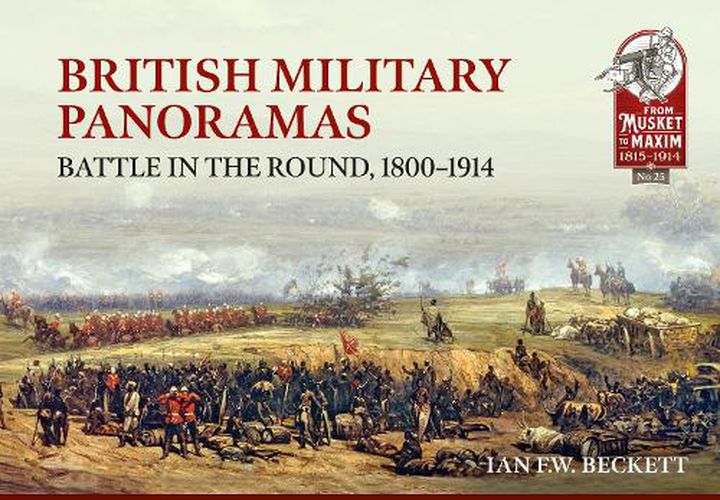Readings Newsletter
Become a Readings Member to make your shopping experience even easier.
Sign in or sign up for free!
You’re not far away from qualifying for FREE standard shipping within Australia
You’ve qualified for FREE standard shipping within Australia
The cart is loading…






Originating in Britain in the 1780s, 360 Degrees panorama paintings were extremely popular in the first half of the nineteenth century and, after a revival, in the last quarter of the nineteenth century. Over 300 large-scale panoramas were painted worldwide in the course of the nineteenth century, and as many as 100 million people worldwide may have viewed one between 1870 and 1900. From the beginning, battle was a popular panorama, well-known surviving examples including those at Gettysburg, Atlanta, Sebastopol, Borodino, and Waterloo. Many of the survivors from the late nineteenth century have been extensively restored and renovated and presented to new audiences with the all the advantages of modern sound and light systems. It can remain a special experience to visit one. They are still being painted in states such as China, North Korea, and Turkey.
As befitted the country where the panorama phenomenon began, battle panoramas were just as popular in Britain, bringing together art, patriotism and mass entertainment in ways that reinforced Britain’s expanding global presence. Those displayed by Robert Barker, Henry Aston Barker, and Robert Burford at the celebrated Leicester Square rotunda between 1800 and 1863 included such subjects as the battles of Waterloo (1815) and Sobraon (1846), and the siege of Sebastopol (1854-55). The rival rotunda in Spring Gardens displayed the memorable canvasses of the Scottish artist, Robert Ker Porter, including the storming of Seringapatam (1799) and the battle of Alexandria (1801). During the substantial revival of interest in the last quarter of the nineteenth century, panoramas were devoted to such battles as Balaclava (1854), Tel-el-Kebir (1882), and Omdurman (1898). Throughout the nineteenth century, there were also ‘moving’ panoramas - series of scenes wound between rollers - covering colonial engagements from Africa to India and touring provincial cities and towns. Panorama al-fresco were outdoor extravaganza incorporating painted backdrops, actors and pyrotechnics at venues such as the Royal Surrey Gardens and Belle Vue in Manchester. All these artistic forms and the reaction to them on the part of art critics, veterans and the wider public are fully described in this unique contribution to the story of British military art.
While panoramas were notoriously prone to destruction from fire and damp, the descriptive keys and guides sold to visitors have survived in many collections in Britain and the United States. In some cases print reproductions and preliminary sketches also remain, as well as photographs of three late nineteenth century examples. Fragments of two panoramas are even preserved on the walls of a Scottish hotel.
Drawing upon extensive primary research, this book explores the forgotten history of British military panoramas.
$9.00 standard shipping within Australia
FREE standard shipping within Australia for orders over $100.00
Express & International shipping calculated at checkout
Originating in Britain in the 1780s, 360 Degrees panorama paintings were extremely popular in the first half of the nineteenth century and, after a revival, in the last quarter of the nineteenth century. Over 300 large-scale panoramas were painted worldwide in the course of the nineteenth century, and as many as 100 million people worldwide may have viewed one between 1870 and 1900. From the beginning, battle was a popular panorama, well-known surviving examples including those at Gettysburg, Atlanta, Sebastopol, Borodino, and Waterloo. Many of the survivors from the late nineteenth century have been extensively restored and renovated and presented to new audiences with the all the advantages of modern sound and light systems. It can remain a special experience to visit one. They are still being painted in states such as China, North Korea, and Turkey.
As befitted the country where the panorama phenomenon began, battle panoramas were just as popular in Britain, bringing together art, patriotism and mass entertainment in ways that reinforced Britain’s expanding global presence. Those displayed by Robert Barker, Henry Aston Barker, and Robert Burford at the celebrated Leicester Square rotunda between 1800 and 1863 included such subjects as the battles of Waterloo (1815) and Sobraon (1846), and the siege of Sebastopol (1854-55). The rival rotunda in Spring Gardens displayed the memorable canvasses of the Scottish artist, Robert Ker Porter, including the storming of Seringapatam (1799) and the battle of Alexandria (1801). During the substantial revival of interest in the last quarter of the nineteenth century, panoramas were devoted to such battles as Balaclava (1854), Tel-el-Kebir (1882), and Omdurman (1898). Throughout the nineteenth century, there were also ‘moving’ panoramas - series of scenes wound between rollers - covering colonial engagements from Africa to India and touring provincial cities and towns. Panorama al-fresco were outdoor extravaganza incorporating painted backdrops, actors and pyrotechnics at venues such as the Royal Surrey Gardens and Belle Vue in Manchester. All these artistic forms and the reaction to them on the part of art critics, veterans and the wider public are fully described in this unique contribution to the story of British military art.
While panoramas were notoriously prone to destruction from fire and damp, the descriptive keys and guides sold to visitors have survived in many collections in Britain and the United States. In some cases print reproductions and preliminary sketches also remain, as well as photographs of three late nineteenth century examples. Fragments of two panoramas are even preserved on the walls of a Scottish hotel.
Drawing upon extensive primary research, this book explores the forgotten history of British military panoramas.